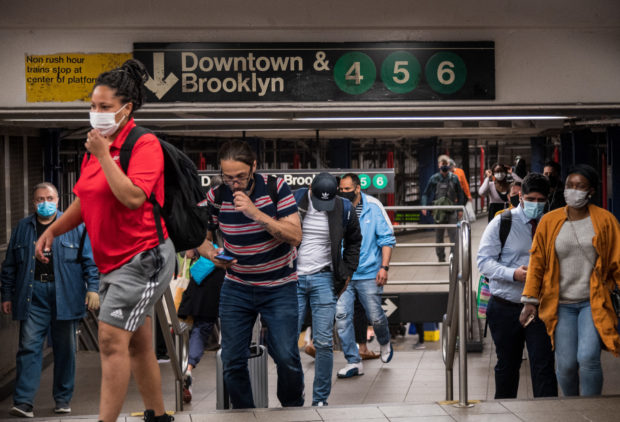
In this file photo taken on May 17, 2021, People commute in Manhattan as the subway returns to twenty-four hour service in New York City. AFP
NEW YORK — There is still a ways to go, but Robert Byrnes has been heartened by signs that more New Yorkers are getting back to the office after the coronavirus pandemic.
“The subway train was absolutely packed this morning,” he said. “I’m back to waiting in lines at lunchtime.”
Still, Byrnes, who heads the East Midtown Partnership, a trade group whose offices are near Grand Central Station, estimated that only about one third of the neighborhood’s workforce has come back to their cubicles.
“Quick meal-type restaurants are still suffering a severe financial impact,” he said. “It’s slowly getting better.”
Other benchmarks corroborate Byrnes’s sense of the lag in New York office employees’ return to in-person workdays.
In May, 62 percent of large employers surveyed by the Partnership for New York City estimated that their workers would be back in the office by September.
But in August, only 41 percent gave that same timeframe.
Building security company Kastle estimates that New York’s buildings are currently at 32 percent of their normal levels, putting it behind the 37 percent average of the nation’s 10 largest cities.
The upshot is that around 30 percent of the stores near Grand Central remain vacant, according to a report published in early October from the Real Estate Board of New York.
The casualties include some longtime institutions, such as the Marriott hotel on Lexington Avenue, which opened in 1924.
Lasting change?
Other New York neighborhoods hit hard by lockdowns to combat Covid-19 are coming back more quickly. The catch is they tend not to rely on office workers.
This includes Times Square, which has seen more tourists of late as Broadway theaters have reopened.
Tom Harris, president of the Times Square Alliance, said the neighborhood now sees about 225,000 people a day, up from 145,000 a day in May.
The hotel occupancy rate of the quarter stood at 82.5 on October 9th, Harris said.
“With 12 more Broadway shows opening up in the next couple of months, with the return of international visitors in November and the office workers going to return a little bit more in 2022, we’re very optimistic about the way Times Square has been recovering,” he said.
But a recent report from commercial real estate firm Cushman & Wakefield paints a mixed picture about Manhattan.
Overall, new office leasing in the famous New York City borough rose in August and September to levels not seen since the start of the pandemic. Despite that, Manhattan’s vacancy rate reached a record 19 percent due to the arrival of additional properties on the market, the Cushman report said.
Rent for newly available office real estate is down about five percent below the levels from a year ago.
Byrnes is among those who think the New York real estate market has experienced lasting change. He questions whether some of the open space may be converted to residential use.
“It’ll never be like it was before the pandemic,” he said, adding that a minority of companies have permanently shuttered their offices in favor of remote work.
Sam Stovall of CFRA Research has shifted his office to his home in Pennsylvania.
Stovall’s firm has shut its 40-person office in southern Manhattan, while keeping a headquarters in the state of Maryland and another office in Malaysia.
“Our management felt that we were equally, if not more productive by eliminating commutes on a daily basis,” Stovall said. “They can save money on real estate.”
Stovall still sees his colleagues on Zoom calls, but says he misses regular business lunches and the chance to go out for drinks on Friday nights.